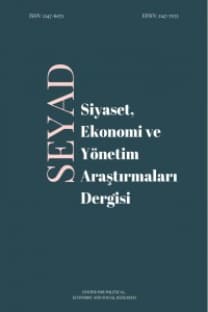Sectoral Analysis of Mergers and Acquisitions Activity of Newly Public Firms: The Case of Borsa Istanbul
.
Sectoral Analysis of Mergers and Acquisitions Activity of Newly Public Firms: The Case of Borsa Istanbul
Initial Public Offerings, Mergers and Acquisitions, Borsa Istanbul, Manufacturing Sector Financial Sector,
___
- Alp, Ali, Ünsal Ban, Kartal Demirgüneş, and Saim Kılıç. 2010. “Internal Determinants of Profitability in Turkish Banking Sector” The ISE Review Vol:12 No:46, 1–13.
- Atici, Gonca, and Guner Gursoy. 2015. “Changing Ownership in the Turkish Non-Financial Corporations Listed on Borsa Istanbul (BIST)” Corporate Ownership & Control 13: 1062–1072.
- Bildik, Recep, and Mustafa K. Yılmaz. 2008. “The Market Performance of Initial Public Offerings in the Istanbul Stock Exchange” BDDK Bankacılık ve Finansal Piyasalar 2: 49–75.
- Brau, J., and S. Fawcett. 2006. Initial public offerings: an analysis of theory and practice. Journal of Finance 61: 399–436.
- Brau, J. C., R. B. Couch, and N. K. Sutton. 2012. The desire to acquire and IPO long-run underperformance. Journal of Financial and Quantitative Analysis 47: 493–510.
- Bulut, Halil İbrahim. 2008. “Investment Bank Reputation and the Post-IPO Operating Performance: The Case of the Istanbul Stock Exchange” The ISE Review Vol:10 No:39, 17–40.
- Bulut, Halil Ibrahim, Fikret Cankaya, and Bünyamin Er. 2009. “Auditing firm reputation and the post-issue operating performance in an emerging market: evidence from Turkish IPO firms” Investment Management and Financial Innovations 6: 212–229.
- Celikyurt, Ugur, Merih Sevilir, and Anil Shivdasani. 2010. “Going public to acquire? The acquisition motive in IPOs” Journal of Financial Economics 96: 345–363.
- Cihangir, Mehmet, and İlkut Elif Kandil. 2009. “Türkiye’de Borsaya Yeni Kote İşletmelerin Halka İlk Arzda Uyguladıkları Düşük Fiyatlandırma Olgusunun Test Edilmesi ve Nedenleri Üzerine Bir Değerlendirme” Muhasebe ve Finansman Dergisi 44: 165–178.
- Dağlı, Hüseyin, and Ahmet Kurtaran. 2008. “İlk Halka Arzlarda Düşük Fiyatlandırmayı Etkileyen Unsurlar: Türkiye Örneği” Muhasebe ve Finansman Dergisi 39: 58–66.
- Durukan, M. Banu. 2002. “The Relationship Between IPO Returns and Factors Influencing IPO Performance: Case of Istanbul Stock Exchange” Managerial Finance 28: 18–38.
- Ercan, Metin, and Serhat Çevikel. 2011. “Survey on IPO underpricing in the Istanbul Stock Exchange” İktisat İşletme ve Finans 26: 85–117.
- Erdogan, Aysa Ipek. 2010. “The Long-Run Performance of Initial Public Offerings: The Case of Turkey” European Journal of Economics, Finance and Administrative Sciences 26: 57–64.
- Ewing, Bradley T., and Ozkan Ozfidan. 2003. “The Performance of Initial Public Offerings in an Emerging Market: The Case of the Istanbul Stock Exchange” International Journal of Business 8(2): 150–167.
- Gönenç, Halit, and Özgür Arslan. 2003. “Capital Structure of the Turkish Domestic and International Real Sector Firms” The ISE Review Vol:7 No:25-26, 41–63.
- Hsieh, Jim, Evgeny Lyandres, and Alexei Zhdanov. 2011. “A Theory of Merger-Driven IPOs” Journal of Financial and Quantitative Analysis 46: 1367–1405.
- Kaderli, Yusuf, and Sezgin Demir. 2008. “Düşük Fiyatlandırılmış Halka Arz Firma Kalitesinin Bir Göstergesi mi?” Muhasebe ve Finansman Dergisi 37: 107–115.
- Karatepe, Yalçın, Elif Karaaslan, and Fazıl Gökgöz. 2002. “Türkiye’de Birincil Halka Arz Uygulamalarının Analizi” İktisat İşletme ve Finans 17: 20–31.
- Karcıoğlu, Reşat, and Ali Özer. 2014. “Determination of Factors Affecting Stock Returns in BIST: Static and Dynamic Panel Data Analysis” Uludağ Journal of Economy and Society 33(1): 43–70.
- Kılıç, Saim, Ali Alp, and Önder Kaymaz. 2009. “Are Compliance Costs Arising From Capital Markets Regulations in Turkey Actually That High to Hinder IPOs?” The ISE Review Vol:11 No:41, 1–24.
- Kıymaz, Halil. 1997. “The Long Run Performances of Turkish Industrial IPOs: 1990-1995 Experience” The ISE Review Vol:1 No:3, 43–67.
- Kiymaz, Halil. 2000. “The initial and aftermarket performance of IPOs in an emerging market: evidence from Istanbul stock exchange” Journal of Multinational Financial Management 10: 213–227.
- Kucukkocaoglu, Guray. 2008. “Underpricing in Turkey: A Comparison of the IPO Methods” International Research Journal of Finance and Economics 13: 162–182.
- Kurtaran, Ahmet, and Bünyamin Er. 2008. “The post-issue operating performance of IPOs in an emerging market: evidence from Istanbul Stock Exchange” Investment Management and Financial Innovations 5: 50–62.
- Mello, Antonio S., and John E. Parsons. 1998. “Going public and the ownership structure of the firm” Journal of Financial Economics 49: 79–109.
- Öztürk, M. Başaran, and Kartal Demirgüneş. 2008. “Determination of Effect of Intellectual Capital on Firm Value Via Value Added Intellectual Coefficient Methodology: An Empirical Study on ISE-Listed Manufacturing Firms” The ISE Review Vol:10 No:37, 59–77.
- Pagano, Marco, Fabio Panetta, and Luigi Zingales. 1998. “Why Do Companies Go Public? An Empirical Analysis” Journal of Finance 53: 27–64.
- Rydqvist, Kristian, and Kenneth Högholm. 1995. “Going public in the 1980s: Evidence from Sweden” European Financial Management 1: 287–315.
- Saraç, Mehmet, and İbrahim Bozkurt. 2011. “KOBİ’lerin Halka Açılma Eğilimleri ve Gelişen İşletmeler Piyasası’nın KOBİ’lerin Halka Açılma İstekleri Üzerine Etkisi” Muhasebe ve Finansman Dergisi 49: 89–98.
- Sayılgan, Güven, and Yahya Sayman. 2010. “The Impact of Ownership Structure on Capital Structure of Manufacturing Firms: Evidence from the ISE (1998-2009)” The ISE Review Vol:12 No:48, 1–11.
- Uygur, Utku, and Oktay Taş. 2014. “The impacts of investor sentiment on different economic sectors: Evidence from Istanbul Stock Exchange” Borsa İstanbul Review 14(4): 236–241.
- Zingales, L. 1995. Insider Ownership and the Decision to Go Public. Review of Economic Studies 62: 425–448.
- ISSN: 2147-6071
- Yayın Aralığı: Yılda 2 Sayı
- Başlangıç: 2014
- Yayıncı: Politik Ekonomik ve Sosyal Araştırmalar Merkezi
Türkiye’de Mali Sürdürülebilirliğin Yapısal Değişimler Çerçevesinde Analizi 2002-2015
Reorder Point and Replenishment Point of Dynamic Inventory Model under Shortages
Türkiye’de Kayıtdışı Ekonomi: Zaman Serisi ve Panel Veri MIMIC Tahminleri
Fatih SAVAŞAN, Fatih YARDIMCIOĞLU, İbrahim DEMİR
The Effects of Quality Management System on Patient Safety Culture in Hospitals
Yunus TAŞ, Ali Talip AKPINAR, Emre İŞÇİ
Pazar Şartlarında Maliyet-Kapasite-Fiyatlandırma ve Kar İlişkisinin Simülasyonu
Impacts of The Global Economic Crisis on Economic Structure: An Example of Turkey’s Economy
Zirai İşletmelere Sağlanan Ipard Desteklerinin Muhasebeleştirilmesi
Ahmet BÜYÜKŞALVARCI, Ali GÜÇLÜ
Osmanlı Hâkimiyetinde Aynoroz Yarımdası’ndaki Kilise ve Manastırlar
Stokastik Sınır Analizi: İstanbul Sanayi Odası’na Kayıtlı Firmalara Yönelik Bir Uygulama
